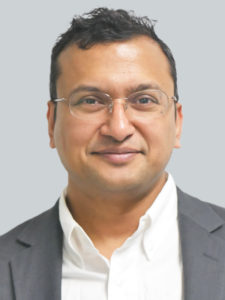On the surface, Nanoscope’s June 3rd news release announcing the remarkable vision-restoring results of its phase 1/2a clinical trial in India might sound like an out-of-nowhere miracle. But in reality, their breakthrough optogenetics drug that restored meaningful vision in 11 previously blind RP patients has been decades in the making. Without ongoing biomedical advancements combined with the rare skill set, unrelenting determination, and unwavering belief in the impossible by company president, Samarendra Mohanty, and his team, this therapy would not exist.
The Backstory
Mohanty, who grew up in a small town in India, was drawn to science because of its ability to create magic that could change the world. After graduating from the Indian Institute of Technology Delhi and the Indian Institute of Science, he began his career as a researcher and scientist at the Center for Advanced Technology in central India. It was there that he was first exposed to applications of light — especially lasers in the diagnosis and treatment of disease. His early work focused on developing devices and technology to detect oral and cervical cancers. But his focus turned to eye diseases when he read an article about optical tweezers by the inventor Dr. Arthur Ashkin, who was later awarded the Nobel prize for his discovery.
Mohanty was soon in Germany working alongside another pioneer in the field, Professor Karl Otto Greulich, and eventually returned home to launch the first optical tweezers and laser micro manipulation lab in India.
By the time Mohanty landed at UC Irvine in 2006, he had a deep expertise in biophysics, lasers, and optics. It was a unique combo that made him the perfect fit for the newly emerging optogenetics field. Mohanty immediately began teaming with ophthalmologists and neuroscientists and set to work to crack the code that could restore vision in millions worldwide.
“Working in collaboration with neuroscientists, we developed different promoter-based opsin genes to target ganglion and bipolar cells of the retina,” notes Mohanty, who adds that this critical work was funded by the Greishaber Foundation. “I also demonstrated for the first time the non-viral delivery of opsin-genes to adult mice retinas by electroporation and spatially targeted laser delivery.”
Like other researchers at UC Irvine, Mohanty started using monochromatic (blue) light to activate channelrhodopsin-expressing ganglion cells in the retina. But later in his career, while working as a professor at the University of Texas, he observed damage to opsin-expressing ganglion cells after chronic use of blue light. And beyond the toxicity issue, Mohanty wasn’t satisfied with just bringing back narrow bans of vision that required intense light and only resulted in restoring a patient’s ability to see shapes, shadows, and stripes. He was determined to restore meaningful vision that gave patients back their lives — which meant achieving vision restoration in a natural, broadband light environment.
“I started fusing different monochromatic (blue, green, and red) opsins to generate broadband light sensitivity,” explains Mohanty. “However, the fused opsin gene was too large to be packed in a known-to-be-safe AAV viral vector. Therefore, we delivered such genes by a non-viral laser method, which needed further instrumentation and image guidance to be translated to humans. Moreover, I found that the broadband opsin generated by fusing three opsin-genes did not have enough sensitivity to be activated at natural/ambient light surroundings, which meant that, like narrowband opsins, we still needed an intensifier to instill vision in subjects with retinal degenerative diseases.”
Mohanty continued to wrestle with the challenge while immersing himself in his academic work as a biophysics professor. Between faculty tasks, setting up biophysics labs, training students, teaching classes, and applying for grants, there wasn’t much time for focused research. But he continued to chip away at it — determined to give people who had been blinded by degenerative eye diseases the ability to see their world again.
“I never considered giving up in spite of major personal and professional challenges,” says Mohanty. “I was distressed by my father’s health issues and death. I was disappointed when narrowband opsin and monochromatic light stimulation did not produce a safe and efficacious outcome. But as a self-motivated scientist and entrepreneur, I would never give up. I am passionate and driven by discovery, translation, and creating a real impact for patients with devastating neurodegenerative diseases.”
The Breakthrough
The breakthrough Mohanty and his team were searching for finally materialized in early 2016, when new MCO mutants were discovered. These opsins possessed three critical attributes: first, they were so sensitive to light that they eliminated the need for an intensifier. Second, they worked fast. And finally, they responded to broadband white or any color of visible light encountered in daily living.
Mohanty began utilizing these MCO opsins — and that’s when the magic happened. He and his colleagues injected their newly refined optogenetics therapy into the bipolar cells of lab mice who had been blinded by RP and were able to activate them into light sensitive cells that worked in natural broadband light environments. While it was a monumental achievement, Mohanty and his colleagues immediately focused on the next step: testing the therapy in people blinded by RP. Then came serendipity. Dr. Mahapatra, a renowned ophthalmologist and retinal surgeon in India, was searching for something to help his patients with RP when he read the pre-clinical trial results published in the journal, Neurophotonics. In early 2017, he traveled to Texas to visit Nanoscope Therapeutics — which Mohanty had recently co-founded with CEO Sulagna Bhattacharya.
“We found him to be equally passionate and truly dedicated to treat his RP patients with severe retinal degeneration,” explains Mohanty. “Since we did not have any experience in conducting a clinical study in India, Dr. Mahapatra introduced us to a CRO who could navigate and coordinate the clinical study.”
Next Steps
Fast forward to now. Thanks to the remarkable results of the India trial, the FDA recently approved a Phase 2b clinical trial for late-stage RP that is currently underway at six locations throughout the United States. The results of that trial are expected to be delivered to the FDA in the third quarter of 2022. If the results from the U.S. trial mirror those of India, Mohanty hopes the FDA will consider an accelerated approval timeline so Nanoscope can start getting their therapy into the eyes of those of us who are clinging to the hope that we will once again be able to see our worlds.
“It means a lot to me and our team to give hope to the patients who have lost their vision due to degenerative eye diseases,” says Mohanty. “To me, it is the purpose of my life. I was very happy that some patients in our phase 1/2a study improved remarkably and that those patients/family members spoke of our therapy as extraordinary. I hope our phase 2b trial will have a similar outcome. The RP patients participating in our study will be contributing to our resolve to enable millions to see again.”
(Editor’s Note: I did everything in my power to get into this clinical trial but was excluded because of a stem cell therapy I received a few years back. I am so happy for those of you who were accepted into this trial and so hope that you will all be able to see your world again and that it will translate into a treatment that the rest of us will be able to access soon.)



Wow! this is very encouraging, hopefully it will work and be accepted by the FDA. Do you know how it really improved the vision of the people who had the priviledge to be part pf the clinical trial.
This is such exciting news. I also hope the clinical trials go well and that soon this treatment will be accessible to everyone. Thank you for spreading this knowledge and hope! Wishing you well!
Hello Ingrid! I am Ruben from Argentina. We haven’t communicated in a long time. Very recently my daughter was identified with a new variation of the PNPLA6 Gene and we need to contact Someone at Nanoscope to tell us if her therapy will be applicable to our case. Can you help us in that?